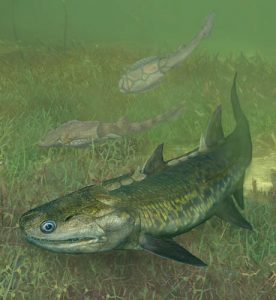
Osteichthyans, or bony fishes, comprise two categories, each containing over 32,000 living species: Sarcopterygii (lobe-finned fishes and tetrapods) and Actinopterygii (ray-finned fishes). Nevertheless, actinopterygians have an obscure early evolutionary history. The earliest definitive actinopterygian is the Middle Devonian (Eifelian) Cheirolepis, with earlier candidates generally represented by fragments subject to differing phylogenetic interpretations. By contrast, earliest Devonian deposits yield a diversity of lobe-finned fishes and recent discoveries from China extend their origin into the late Silurian.
The Early Devonian (Lochkovian) Xitun Formation of Yunnan, China, provides remarkable fossils to illustrate the evolutionary origins of individual sarcopterygian lineages, but apparently lacks any actinopterygians. Meemannia is the newest—and least understood—member of this fauna. Represented by four isolated skull roofs and a referred jaw, Meemannia presents an intriguing mosaic of characteristics: histology interpreted as a precursor to the “cosmine” of rhipidistian sarcopterygians (lungfishes plus tetrapods); an undivided braincase and skull roof resembling that of actinopterygians. Previous phylogenetic analyses placed Meemannia as the earliest-diverging sarcopterygian, based on histological features.
In a study published May 19 in Current Biology, Drs. Lu Jing and Zhu Min, of the Chinese Academy of Sciences and their collaborators used high-resolution computed tomography to re-examine the most complete remains of Meemannia, and presented new details of the internal skeleton and one of the earliest osteichthyan endocasts. Researchers revised hypotheses of bone histology in the ancestor of bony fishes, and found that “cosmine”-like tissues, previously thought to unite Meemannia with lobe-fins, are widely distributed among early bony fishes, including the ray-fin Cheirolepis. This finding revealed that Meemannia, once considered a lobe-fin, is the oldest ray-finned fish, providing new evidence for the origin of ray-finned fishes.
“The enigmatic osteichthyan Meemannia from the Early Devonian of China, about 415 million years ago, was previously identified as an exceptionally primitive lobe-finned fish. It combines ‘cosmine’-like tissues taken as evidence of sarcopterygian affinity with actinopterygian-like skull roof and braincase geometry, including endoskeletal enclosure of the spiracle and a lateral cranial canal,” said Dr. Lu Jing. “Our comparable study on histological structures in undoubted ray-finned fishes indicates that they are general osteichthyan features.”
“Phylogenetic analysis places Meemannia as an early-diverging ray-finned fish, resolving it as the sister lineage of Cheirolepis plus all younger actinopterygians,” said study co-author Dr. Sam Giles, of the University of Oxford. “This brings the first appearance of ray-fins more in line with that of lobe-fins and fills a conspicuous faunal gap in the otherwise diverse late Silurian-earliest Devonian vertebrate faunas of the South China Block.”
“The rarity of early ray-fins supports a ‘long-fuse’ model for actinopterygian diversification,” said Dr. Zhu. “Actinopterygians persisted at low levels of numerical abundance, taxonomic richness, and morphological disparity for millions of years before undergoing apparently explosive diversification in the early Carboniferous after the end-Devonian Hangenberg Event. Meemannia provides an anatomical snapshot of the earliest stages of ray-finned fish evolution, at a time when their rarity and limited ecological variety gave no indication of the dominant role they would play in aquatic vertebrate ecosystems of the future.”
Note: The above post is reprinted from materials provided by Chinese Academy of Sciences.










